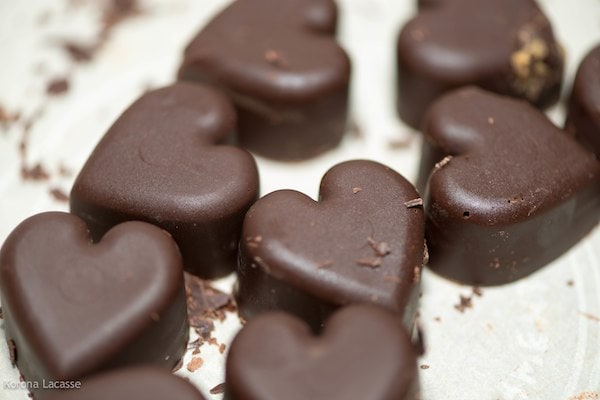
[Image above] Credit: Korona Lacasse, Flickr (CC BY 2.0)
Late last year, I reported that researchers at Fraunhofer were studying the formation of fat bloom on the surface of chocolate—the white microbial-looking stuff that turns out to be harmless.
Who knew there was so much materials science behind one of our favorite—and most healthy—confections?
But wait, there’s more… It turns out the delicious materials science of chocolate didn’t end there.
A group of researchers from the Deutsches Elektronen-Synchrotron (DESY), Hamburg University of Technology (TUHH), and Nestle has taken the chocolately exploration a step further by studying just how fat bloom forms.
“Although fat blooming is perfectly harmless, it causes millions in damage to the food industry as a result of rejects and customer complaints,” explains main author Svenja Reinke in a DESY press release. “Despite this well known quality issue, comparatively little has been known until now about its root causes.”

Microscope view of fat bloom on chocolate. Credit: Svenja Reinke; TUHH
To probe chocolate, the team lined up DESY’s PETRA III synchrotron to use small-angle X-ray scattering to investigate the real-time fat dynamics of a ground powder of chocolate—cocoa, sugar, milk powder, and cocoa butter.
“The technology used to examine the samples shows us both the fat crystals and the pores inside the product, down to a scale of a few nanometers,” lead researcher Stefan Heinrich says in the release.
Wetting the powder with a few drops of sunflower oil provided a conduit to study the migration of fats throughout the chocolate.
“First of all, wetting takes place within seconds. The oil penetrates very quickly into even the smallest pores, probably through capillary action,” Reinke says in the release. “Over a period of hours, the liquid fat dissolves additional crystalline lipid structures, which makes the entire structure of the chocolate softer. This in turn increases the migration of lipids.”
That migration allows the lipids to sneak through cracks and pores in the chocolate and migrate to the surface, causing fat bloom.
“For the first time, we have been able to track in detail the dynamic mechanisms that lead to the creation of fat bloom,” says DESY scientist Stephan Roth, head of the P03 beamline at PETRA III, in the release. “The joint study has supplied important information as to how we can study structural changes in such ‘everyday’ multi-component systems.”

With DESY’s X-ray source PETRA III, the scientists could follow the migration of liquid fat (yellow) through chocolate live for the first time. The characteristic X-ray pattern (right) reveal details down to nanometer sizes. Credit: Svenja Reinke; TUHH
Better yet, the results directly translate into ways for the food industry to improve chocolate to prevent fat bloom. That means minimizing the amount of liquid fat or its ability to migrate in the chocolate.
“One consequence might, for example, be to reduce the porosity of the chocolate during manufacture, so that the fat migrates more slowly,” Reinke says in the release. “Another approach is to limit the amount of fat that is present in a liquid form by storing the product in cool, but not too cold, conditions—18 degrees Celsius is ideal. Just a few degrees make a big difference. At 5 degrees, basically, all cocoa butter is solid; and above about 36 degrees everything is liquid.”
The team says that controlling crystallization of the chocolate—which is already an important part of making chocolate—can also help prevent fat bloom, because the six crystal forms of cocoa butter differentially impact the amount of fat in liquid form.
The paper, published in ACS Applied Materials & Interfaces, is “Tracking structural changes in lipid-based multicomponent food materials due to oil migration by microfocus small-angle X-ray scattering” (DOI: 10.1021/acsami.5b02092).

Inner structure of chocolate: liquid fats (yellow) can migrate through the mix of cocoa (dark brown), milk powder (light brown), and sugar (white). Credit: Svenja Reinke; TUHH
Author
April Gocha
CTT Categories
- Material Innovations
- Nanomaterials


